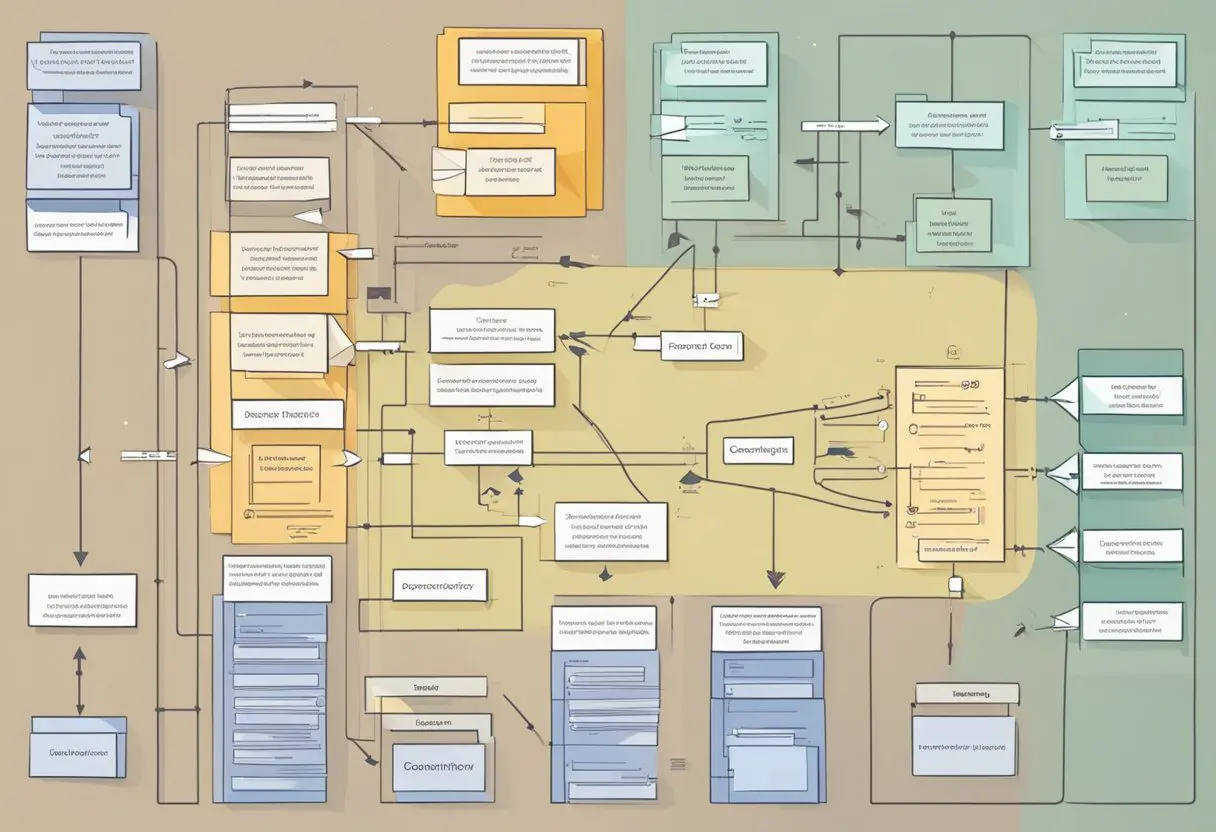Table of Contents
A content workflow is a structured approach that organisations follow to produce, manage, and distribute content effectively. It encompasses the sequence of steps from the initial concept through to the publishing and promotion of content. The goal is to streamline the content creation process, ensuring consistency, efficiency, and quality at every stage. This organised method is particularly beneficial for teams that handle large volumes of content across various platforms, serving diverse audience needs.

The design of a content workflow involves delineating clear roles and responsibilities for content creation and oversight. This clarity supports the collaboration of cross-functional teams, which may include writers, editors, graphic designers, and digital marketing specialists. Additionally, the use of specialised tools and software for tasks such as content management, editorial calendaring, and project tracking facilitates the smooth functioning of the workflow. This integration of processes and technology ensures that content reaches its intended audience at the right time and in the most engaging format.
Adapting a thorough content workflow can significantly impact an organisation’s ability to communicate with its audience effectively. It provides a roadmap for creating valuable content that resonates with readers, listeners, or viewers while maintaining the brand’s voice and message integrity. By optimising these processes, companies can enhance their content’s reach and influence, which in turn, can lead to increased audience engagement and business growth.
Planning and Strategy

Effective content workflow begins with meticulous planning and a robust strategy. It requires clearly defined objectives and an understanding of the intended audience to chart a course for success.
Defining Content Goals
Content goals are the cornerstone of any content strategy. They should align with broader marketing goals to ensure that every piece of content created serves a purpose. For instance, increasing brand awareness might necessitate content that is informational and easily shareable, whereas generating leads may require more targeted content that speaks directly to the target audience‘s needs.
Understanding the Audience
Knowing the audience is imperative for creating content that resonates and engages. Content marketing efforts hinge on a deep understanding of who the audience is, what challenges they face, and what information they seek. Utilising keyword research helps to uncover the language and terms the audience uses, which informs the creation of relevant and impactful content.
Creating a Content Calendar
A content calendar is indispensable for strategic planning. It acts as a roadmap, outlining when and where content will be published and ensuring a steady and consistent output. The calendar should account for key dates relevant to the audience, planned promotional activity, and any external events that could impact content engagement. Aligning content strategy with the calendar enables teams to prepare in advance, reducing last-minute rushes and maintaining quality.
Example of a simple content calendar structure:
| Date | Content Type | Title | Target Audience | Keywords |
|---|---|---|---|---|
| 01/06/2024 | Blog Post | “5 Tips for Eco-Friendly Living” | Eco-conscious consumers | eco-friendly, sustainable living |
| 15/06/2024 | Social Media | “Join our #EcoChallenge” | Social media followers | EcoChallenge, GoGreen |
| 30/06/2024 | Newsletter | “Monthly Green Roundup” | Subscribers | monthly digest, green tips |
By utilising such a calendar, teams ensure that their content is timely, relevant, and executed in alignment with their planned objectives.
Workflow Design

In the arena of content creation, the design of an efficient workflow is critical for streamlining tasks and enhancing productivity. It involves identifying roles, utilising the right tools, and developing custom templates tailored to the project’s needs.
Establishing Roles and Responsibilities
Defining clear roles and responsibilities is the cornerstone of any successful content workflow. Project management must ensure that each team member knows precisely what is expected of them. For instance, content strategists may be responsible for ideating themes, while writers develop the material, and editors refine it. A task-based workflow might assign steps such as research, writing, and editing to specific roles, ensuring accountability at each stage.
Choosing the Right Tools for Efficiency
To maintain high productivity levels, selecting appropriate tools is crucial. A robust project management tool can automate status-based workflows, track progress, and manage resources efficiently. Important features might include task assignment, deadline tracking, and collaborative spaces. Tools like Smartsheet enable teams to double-click into workflow charts, customising the process flow to fit the project at hand.
Creating a Content Workflow Template
A content workflow template exemplifies a pre-defined structure that guides teams through content creation stages. This template can be a reference point for all team members, highlighting each step from brainstorming to publication. For a cohesive approach, templates such as those found on ClickUp can integrate production frequency and type of content to be created, providing an at-a-glance status of ongoing projects.
Content Creation and Management
Effective content management hinges on a robust process that encompasses content ideation, rigorous editing, and strict quality controls. This ensures that high-quality, consistent content is produced. The following sections detail the critical stages involved in the content workflow.
Initiating the Content Creation Process
The content creation process begins with ideation, where concepts are developed and drafted into an initial outline. They set the stage for creating content that not only resonates with the audience but also aligns with organisational goals. Key components of this phase include:
- Ideation: Brainstorming session to produce a wealth of ideas.
- Content Strategy: Aligning topics with brand objectives and user needs.
- First Draft: Writing begins, translating ideas into tangible content.
Content Editing and Approval Flow
After the first draft, content moves through a rigorous editorial process. Each piece should be:
- Proofread: Ensuring that grammar, spelling and punctuation are correct.
- Reviewed: Content is examined for adherence to style guidelines and accuracy.
- Approved: Final oversight by editors or stakeholders authorises content for publication.
This stage is critical to guarantee that the content meets the predefined standards required for high-quality outputs.
Ensuring Consistency and Quality
Quality content is not just well-written; it must also be consistent across all platforms. A content workflow that incorporates the following elements can help achieve this:
- Style Guide: A comprehensive guide for writers and editors ensures consistent voice, tone, and format.
- Quality Checks: Regular audits for readability, engagement, and value to the reader.
- Feedback Loops: Mechanisms to incorporate constructive feedback, allowing for continuous improvement.
Publication and Distribution
The “Publication and Distribution” section of a content workflow involves releasing the final content to the public and employing strategies to increase its reach. This includes ensuring content is polished, scheduling posts, executing promotional campaigns, analysing engagement metrics, and addressing any impediments to efficiency.
Finalising and Publishing Content
Before a blog post reaches the audience, it must undergo final edits to ensure accuracy, tone, and brand alignment. The publishing schedule is crucial at this stage to ascertain that content goes live at the optimal time for maximum exposure. Publishing involves not only a final checklist of quality assurance but also the technical aspects of uploading content to the relevant platforms, whether it’s a blog post or other media.
Content Promotion Strategies
Once the content is published, promotion strategies must kick in to amplify its visibility. This may include scheduling social media posts, email marketing campaigns, or leveraging influencers. The efforts put into a content’s promotion need to be both strategic and creative to stand out in a crowded online space, aligning promotional activities with the overall goals of the marketing campaign.
Analysis of Content Performance
Analysing content performance post-publication helps in understanding its impact. Key performance indicators (KPIs) should be monitored, including traffic, engagement, and conversion rates. These metrics provide insights into the content’s performance against objectives, guiding future strategies for publishing content.
Bottleneck Identification and Resolution
Identifying bottlenecks that hinder the content workflow is critical. These can occur at any point, from idea generation to content distribution. It’s essential to pinpoint these obstructions promptly and find resolutions to streamline the workflow, ensuring that the process of publishing content remains consistent and effective.
Optimisation and Support
Optimisation in content workflow is pivotal for the enhancement of efficiency and the support for everyday content production tasks. This section sheds light on the utilisation of project support tools, the management of graphic design and visual assets, and the tactics for increasing stakeholder engagement to bolster overall content efficacy.
Leveraging Project Support Tools
The integration of project support tools can fundamentally transform the operational landscape of content production. They offer dynamic resource allocation, streamline workflow tracking and enable marketing teams to monitor progress with precision. Tools like Smartsheet facilitate the organisation of documents and ensure everyone adheres to prescribed deadlines, significantly cutting down the time spent on managerial tasks.
Graphic Design and Visual Assets
Efficient management of graphic design elements is critical for producing compelling website content. Support from skilled graphic designers is necessary to create visuals that resonate with the audience. They utilise a myriad of tools and platforms to develop, store, and retrieve visual assets on demand. A structured content workflow that integrates the production of visual assets within the overall strategy ensures consistent and high-quality output.
Enhancing Stakeholder Engagement
Enhanced stakeholder engagement is achieved through transparent communication and active involvement in the content workflow process. Documenting each phase and providing clear guidelines and updates to all stakeholders—including content teams and clients—optimises workplace engagement and supports the content production cycle. By tailoring the workflow to include regular touchpoints, stakeholders remain informed and vested in the project’s success, contributing to the release of high-quality content.
Content Operations and Sustenance
In the sphere of content management, the trifecta of managing production schedules, streamlining approval workflows, and devising a sustainable content plan ensures operational longevity and effectiveness.
Managing Content Production Schedules
Content production schedules are vital for a content team to meet deadlines and sustain productivity. They must clearly outline due dates for each task and assign responsibilities to team members. Project managers can utilize tools such as Gantt charts to visualize project timelines and ensure all involved are aware of their parts in the production sequence. Effective scheduling helps prevent missed deadlines, keeping the content workflow seamless and coherent.
Streamlining the Approval Workflow
A well-defined approval process accelerates content delivery while maintaining quality standards. The approval workflow should minimize bottlenecks, delineating each reviewer’s role within the team. Content project management must ensure that each piece of content receives approval from necessary stakeholders before proceeding to the next stage. This systematic approach reduces confusion and hastens content production.
Devising a Sustainable Content Plan
The longevity of content operations hinges on a sustainable content plan aligned with business objectives and audience needs. It includes thoughtful planning for resource allocation and producing content that resonates with the target audience over the long term. A content management workflow must be adaptable to change, fostering a resilient approach that evolves with market trends and organizational growth.
Frequently Asked Questions
In this section, you’ll find detailed answers about content workflow, from its integration within management systems to the roles of coordinators in the process.
What constitutes an effective content creation workflow?
An effective content creation workflow typically involves a sequence of structured activities designed to produce and manage content efficiently. This process usually includes planning, creation, review, approval, publication, and analysis stages, and aims to boost productivity and content quality.
How does one integrate a content workflow into a content management system?
Integration of a content workflow into a content management system requires setting up clear protocols and stages within the software to manage the lifecycle of the content. Ensuring proper tools and roles are defined within the system facilitates a smooth workflow that adheres to deadlines and maintains quality.
What are the essential steps to developing a content workflow from scratch?
Developing a content workflow from scratch necessitates outlining all stages of content creation, from ideation to publishing. These steps must include defining the roles involved, establishing timelines, and creating guidelines for quality assurance to manage the content effectively.
Could you identify popular tools utilized in content workflow management?
Popular tools used in content workflow management feature project management platforms like Trello and Asana, content collaboration tools such as Google Workspace, and specific content management systems like WordPress with editorial calendar plugins.
What roles does a Content Workflow Coordinator perform within the workflow process?
A Content Workflow Coordinator manages the orchestration of the content production process. They are responsible for scheduling, overseeing content quality, ensuring adherence to timelines, and coordinating with team members to facilitate a smooth workflow.
How can one effectively utilise software like Bynder in managing content workflows?
Bynder is a digital asset management platform that helps teams create, find, and use content more effectively. To utilise Bynder in content workflow management, one must leverage its organisational tools, collaborative features, and robust workflow modules to streamline processes and maintain brand consistency.